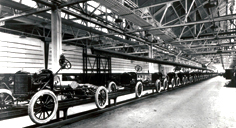The moving assembly line at Highland Park was perhaps Ford Motor Company's single greatest contribution to automotive manufacturing. The line proved tremendously efficient, helping the company to far surpass the production levels of its competitors, while making the vehicles more affordable.

The Price of Success
The Model T, introduced in 1908, was an immediate success, but as they rolled out of the Ford factory on Piquette Avenue in Detroit, Henry Ford realized that more spacious production facilities were required. He purchased 60 acres in the city of Highland Park, an enclave situated within the boundaries of Detroit.
In addition to needing more space, Henry Ford also realized he would have to improve his manufacturing system. Like other manufacturers, the company built cars one at a time—the chassis stayed in one place and didn't move until the car was finished. These handmade automobiles required many hours of costly skilled labor that kept car prices high.
Rethinking the Manufacturing Process
To improve his manufacturing process, Henry Ford latched onto a concept that was, for manufacturing, rather revolutionary—instead of bringing the man to the work, the work must be brought to the man. Henry and Charles Sorensen, a hardworking Dane Ford had hired as his assistant in 1905, kept experimenting to find the solution.
At first, cars were mounted on movable benches or "cradles" that were pushed from one workstation to the next, where parts were attached. Ford workers then tried moving parts along the production line on inclined slides. This speeded up the production, but the cars were still largely handmade.
Birth of the Moving Assembly Line
A breakthrough came in April 1913. A production engineer in the flywheel magneto assembly area tried a new way to put this component's parts together. The operation was divided into 29 separate steps. Workers placed only one part in the assembly before pushing the flywheel down the line to the next employee.
Previously, it had taken one employee about 20 minutes to assemble a flywheel magneto. Divided among 29 men, the job took 13 minutes. It was eventually trimmed to five minutes. This approach was applied gradually to the construction of the engine and other parts.
The First Moving Assembly Line at Highland Park
On October 7, 1913, a rudimentary final assembly line was rigged at the new Highland Park plant. A chassis was pulled slowly across the factory floor by rope and windlass. Parts and 140 assemblers were stationed along the 150-foot line. As the winch dragged the chassis across the floor, workers attached parts to the car. With this new assembly line, production time for a single vehicle fell from 12 hours and 30 minutes to five hours and 50 minutes.
Soon the line was improved with a power-drive "endless" conveyor system that was flush with the floor and wide enough to accommodate the chassis with room for workers on both sides. By 1914, continuous improvement had whittled the time required for assembly to 93 minutes.

